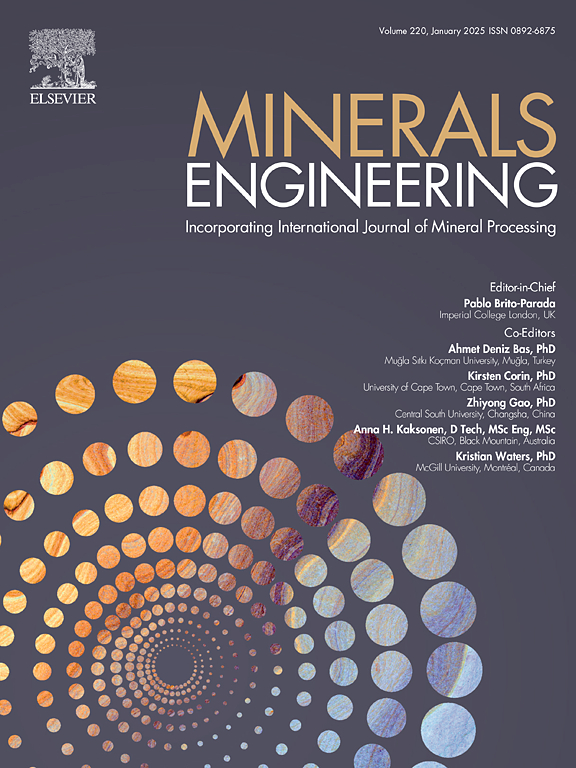二氧化钛废酸共萃取高铬钒渣中钒(IV)和铬(III)的优化及动力学分析
IF 4.9
2区 工程技术
Q1 ENGINEERING, CHEMICAL
引用次数: 0
摘要
从高铬钒渣(HCVS)中共萃取钒(V)和铬(Cr)的常规方法通常伴随着有毒的V(V)和Cr(VI)残留物和废水的形成。本研究提出了一种用二氧化钛废酸(TWWA)直接加压浸出HCVS中V(IV)和Cr(III)的新工艺,以消除有毒V(V)和Cr(VI)形成的潜在威胁。为了深入了解HCVS的矿物学特征和释放行为,进行了矿物释放分析(MLA)。随后,利用响应面法(RSM)优化浸出条件,深入研究了V在加压酸浸过程中的动力学。通过优化浸出条件,V、Cr、Fe、Mn和Ti的浸出效率分别为97.98%、92.01%、94.70%、91.03%和0.56%。动力学分析表明,化学反应是浸出过程的控制步骤。值得注意的是,这种方法确保了有价金属的有效浸出,浸出液中存在的价态是V(IV), Cr(III)和Fe(II)。通过减少有毒残留物的产生和减少对环境的污染负担,本研究为从HCVS中可持续和环保地提取V和Cr提供了令人信服的理由。本文章由计算机程序翻译,如有差异,请以英文原文为准。
Optimization and kinetic analysis of co-extraction of vanadium(IV) and chromium(III) from high chromium vanadium slag with titanium dioxide waste acid
Conventional methods for the co-extraction of vanadium (V) and chromium (Cr) from high chromium vanadium slag (HCVS) are normally accompanied with the formation of toxic V(V) and Cr(VI) residues and wastewater. In this study, a new process for the co-extraction of V(IV) and Cr(III) from HCVS with titanium dioxide waste acid (TWWA) by direct pressurized leaching is proposed to eliminate the looming threat of toxic V(V) and Cr(VI) formation. To gain insights into the mineralogical characteristics and liberation behavior of HCVS, mineral liberation analysis (MLA) was performed. Subsequently, the response surface methodology (RSM) was used to optimize the leaching conditions and delve into investigate the kinetics of V in the pressurized acid leaching process. By optimizing the leaching conditions, the leaching efficiencies of V, Cr, Fe, Mn, and Ti were 97.98%, 92.01%, 94.70%, 91.03%, and 0.56%, respectively. Kinetic analysis showed that the chemical reaction was the controlling step of the leaching process. Notably, this method ensures the efficient leaching of valuable metals, and the valence states present in the leach solution are V(IV), Cr(III), and Fe(II). By mitigating the generation of toxic residues and reducing the pollution burden on the environment, this study makes a compelling case for the sustainable and environmentally responsible extraction of V and Cr from HCVS.
求助全文
通过发布文献求助,成功后即可免费获取论文全文。
去求助
来源期刊

Minerals Engineering
工程技术-工程:化工
CiteScore
8.70
自引率
18.80%
发文量
519
审稿时长
81 days
期刊介绍:
The purpose of the journal is to provide for the rapid publication of topical papers featuring the latest developments in the allied fields of mineral processing and extractive metallurgy. Its wide ranging coverage of research and practical (operating) topics includes physical separation methods, such as comminution, flotation concentration and dewatering, chemical methods such as bio-, hydro-, and electro-metallurgy, analytical techniques, process control, simulation and instrumentation, and mineralogical aspects of processing. Environmental issues, particularly those pertaining to sustainable development, will also be strongly covered.
 求助内容:
求助内容: 应助结果提醒方式:
应助结果提醒方式:


